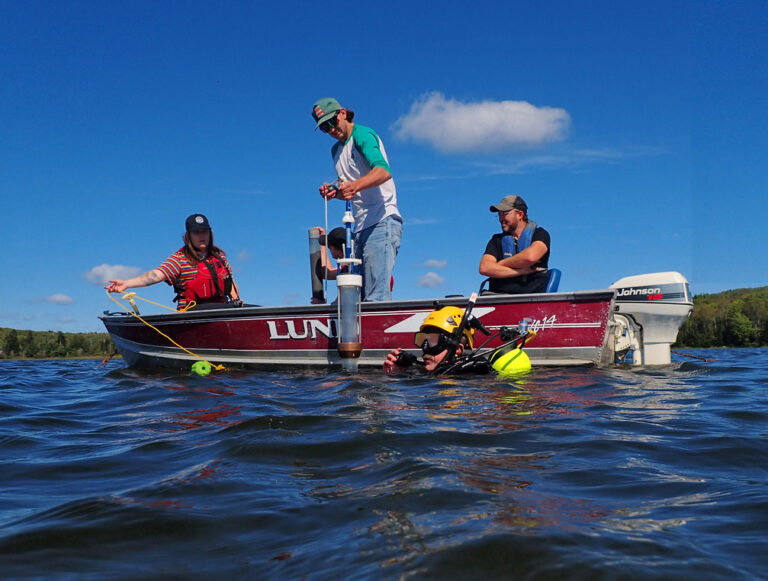Project Description
OVERVIEW: The proliferation of harmful cyanobacteria algal blooms (cyanoHABs) is recognised as a global environmental problem threatening the quality of surface waters. These can have devastating effects on aquatic biota, fisheries and human health via the contamination of drinking water supplies. In spite of advances in cyanoHAB monitoring and detection, the specific mechanisms of toxic bloom proliferation remain poorly understood, although nutrient enrichment driven by land use change (e.g. agricultural intensification) and climate change are major contributory factors (Benayache et al., 2019). As well as promoting algal growth via temperature change, climate change can significantly alter the runoff of nutrients into waterbodies, leading to cyanoHAB development. Re-suspension of surficial, nutrient-rich sediments during heavy rains can have a similar effect, particularly in shallow lakes. There is a pressing need to better understand these and other controls on cyanoHAB formation in light of future predicted climate change, and to consider how the combined effects of nutrients and climatic stressors will impact biotic communities in lakes and other sensitive water bodies.
This project will use a combination of palaeolimnological (geochemistry, fossil pigments, microfossils), water quality monitoring and climate data to examine the controls on cyanoHAB development in a series of vulnerable lakes in Northern Ireland, UK. Palaeolimnological approaches, which utilise the rich archive of environmental information preserved in sediment cores, have great potential for understanding the development and impacts of toxigenic cyanobacteria bloom events (Erratt et al., 2023), and can greatly extend the inferences that can be drawn from water quality monitoring data alone. Sediment cores for ultra-high resolution (mm-scale) analysis will be collected from lakes with a known history of cyanoHAB proliferation. The palaeolimnological work, which will focus especially on multiproxy records from the last ca. 50-300 years, will be supplemented by statistical and GIS analysis of physicochemical monitoring data and select landscape limnological variables in the study catchments (e.g. lake connectivity) to further elucidate the drivers of bloom events. The results are likely to inform lake monitoring practices as well as future management and remedial efforts.
TRAINING: The successful applicant will receive training in relevant analytical techniques (including diatoms and other microalgae, pigments, geochemistry, stable isotopes and geochronology), field sampling and statistical approaches from the supervisors in QUB and the wider advisory team. Geochronological analysis will be undertaken in the QUB 14CHRONO Centre for Climate, the Environment and Chronology. The student will visit the Global Water Institute, Ottawa to receive training in advanced geochemical and sedimentological techniques (e.g. cyanotoxin metabolite detection) under the guidance of external project supervisors Tim Patterson and David McMullin. The student will join a vibrant and diverse interdisciplinary research community in QUB’s School of Natural and Built Environment and will have the opportunity for regular interaction with biologists and environmental chemists in QUB, Aberdeen and beyond through the supervisors, external advisory team and the wider QUADRAT network. Prospective applicants should have a strong grounding in environmental or biological science, geochemistry, ecology/palaeoecology, physical geography or a related subject at undergraduate and/or Masters level and some experience in (geo)statistics or GIS.
CANDIDATE BACKGROUND
Essential skills: A strong grounding in environmental or biological science, ecology/palaeoecology, physical geography or a related subject at undergraduate and/or Masters level; some UG-level knowledge of statistics
Desirable skills: Some prior experience in micro- or macrofossil analysis (e.g. pollen, diatoms; macrophytes); field sampling (e.g., core collection), geochemical or sedimentary analysis; data handling, geostatistics/R or GIS.
Photo credit: Matthew Marshall, QUB
Supervisors
Helen RoePrimary Supervisor: | Profile: Helen Roe Email: h.roe@qub.ac.uk Institution: Queen's University, Belfast Department/School: School of Natural and Built Environment |
Vasilis LoucaSecondary Supervisor: | Profile: Vasilis Louca Email: v.louca@abdn.ac.uk Institution: University of Aberdeen Department/School: School of Biological Sciences |
Maarten BlaauwAdditional Supervisor: | Profile: Maarten Blaauw Email: maarten.blaauw@qub.ac.uk Institution: Queen's University, Belfast Department/School: School of Natural and Built Environment |
References
Benayache, N. et al. (2019) An Overview of Cyanobacteria Harmful Algal Bloom (CyanoHAB) Issues in Freshwater Ecosystems. In: Limnology – Some New Aspects of Inland Water Ecology. DOI:10.5772/intechopen.84155
Erratt, K.J., Creed, I.F., Lobb, D.A., Smol, J.P., Trick, C.G. (2023). Climate change amplifies the risk of potentially toxigenic cyanobacteria. Global Change Biology, 29(18) https://doi.org/10.1111/gcb.16838
QUADRAT Themes
- biodiversity
- earth-systems
- environmental-management






















































